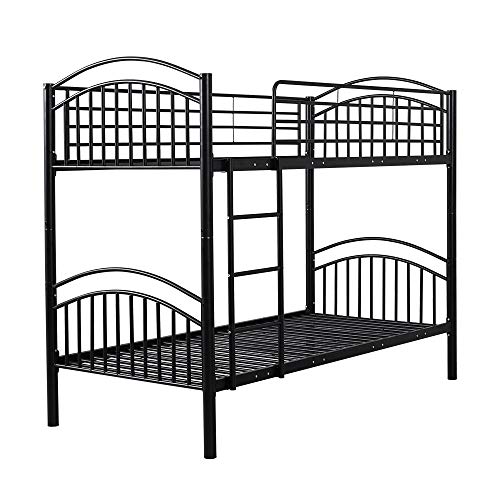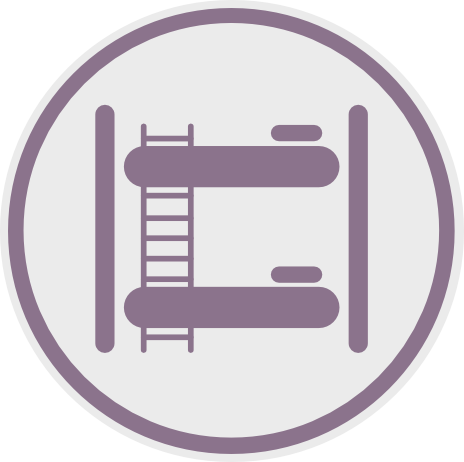How Bunk Bed And Single Bed Changed My Life For The Better
페이지 정보

본문
 Choosing Between a Bunk Bed and Single Bed
Choosing Between a Bunk Bed and Single BedWhen deciding on bunk bed or single beds, it's important to think about the mattress size choices. Twin mattresses are ideal for children or adults who prefer to sleep on their own. They are best suited to rooms that measure 7 feet by 10 inches.
A twin over full bunk bed is great for families that have children of different ages. The futon metal bunk bed single is a popular option. It includes a lower Western style futon that can be transformed into a bed.
Space Saving
Bunk beds offer an unique solution for households looking to maximize space. This kind of furniture can allow families to place two beds in the same space, thereby making space that could be used to build other furniture such as dressers and desks.
Bunked beds are a great option for kids' rooms, since they offer more space for playing and studying. They also save room in smaller living spaces. They can also be an ideal alternative to single bunk bed mattresses bunk bed with slide - https://articlescad.com/ - bed frames for adults. The most sophisticated bunkbed owners can incorporate accessories and decorations that can enhance their bed and make the beds appear more cozy.
The main benefit of a bunk beds is that it permits children to share the same room. This arrangement can help reduce conflicts in the home by giving children the opportunity to share the same room. It also increases the amount of storage space available in the child's bedroom by removing the need for extra dressers and other large pieces of furniture.
There are many different types of bunk beds, but they all use similar designs to maximize space. Standard bunk beds are made up of two mattresses of the same size stacked on top of each other. A full-size twin bed is also arranged in the same way, but with two beds of full size on the bottom and a twin mattress on top. A futon bunk consists of a standard bunk and a western style futon couch which converts to a sofa. It is a great option for families seeking traditional, space-saving bunks.
While bunk beds are a more affordable option than single beds, they could require regular maintenance and repairs because of their multi-tier structure. In addition, bunk beds might not be as accessible for patients with mobility issues or who are at risk of falling as compared to single beds. When choosing bedding for their facilities healthcare facilities should consider balancing the initial cost with the long-term value.
Single beds are less costly to maintain and easier to repair than bunk beds. They can also be moved to meet the needs of patients or accommodate different the layout of rooms. This flexibility is particularly beneficial for facilities for behavioral health care that have to accommodate a broad range of patient demographics.
 Convenience
ConvenienceBunk beds are an excellent option for families with children who differ in age. A full bunk over a twin configuration works well for siblings with different preferences for sleeping. For example, younger children may prefer being close to dad and mom, while older children may prefer sleeping on their own.
Bunk beds also save money because they can reduce the amount of mattresses that need to be purchased. Some bunk bed models also have built-in storage systems that eliminates the need for separate dressing rooms for patients that help to reduce clutter and maximize space.
Another benefit of bunk beds is their capacity to help facilities increase bed capacity. They are ideal for cramped rooms, like rehabilitation centers and youth psychiatric units, where patients often share accommodations. They can be stacked in long-term health facilities to accommodate large groups.
While bunk beds can provide a variety of benefits, they can also be more difficult to clean and maintain than single beds. The added stress on frames and joints can cause wear and tear, which will require more frequent inspections and maintenance. The design of the bunk bed could create difficulties for those with mobility issues or health issues. The climb up and down the ladder could be difficult and potentially hazardous, especially for seniors.
Single beds On the other hand can be moved around to accommodate different layouts in rooms and provide patients with a customized environment. Journal of Environmental Psychology states that this flexibility can increase occupant satisfaction by 25 percent.
Be aware of your patient's demographics, your space constraints and your maintenance requirements when choosing the ideal one bed bunk bed for your facility. Bunk beds can be a great option for facilities looking to conserve space or require less set-up time. Single beds are ideal for rooms with high turnover or a limited budget.
If you are considering a bunk bed, be sure to choose a model with a mattress that is easy to clean. The most suitable bunk mattress is an innerspring hybrid latex, memory foam, or latex However, some people might prefer to use futon mattresses. Verify that the mattress on a bunk bed is upholstered or slatted. A bed with slats is a bunk bed that has an underside made of slats, or slat roll which are hammered together or screwed together to support the mattress.
Safety
Bed safety is a major aspect when it comes to furnishing health care facilities. Bunk beds are able to provide a secure environment for patients by efficiently utilizing space while minimising risk. They can also lower injuries because they have a lower center-of-gravity, which is good for the physically impaired and elderly.
Regular maintenance and proper assembly are the key to bunk bed safety. Check for loose or unstable pieces and strengthen weak points to prevent structural failure. Adhere to manufacturer-recommended weight limits, as excess loading can compromise stability. To avoid entrapment or falling ensure that ladders are properly attached to the frame.
After they have demonstrated that they are able to safely climb up and down, should children be allowed to sleep on the top bunk. They should be capable of taking care of their personal hygiene without supervision or assistance, including using the bathroom and dressing themselves. Furthermore, bunk beds should be placed far enough from windows to minimize the risk of injuries resulting from windows.
Bunk beds have a drawback in that they're not well-suited to separating noise and motion which can be irritating to light sleepers. The sleepers in the bottom bunk could feel or hear their fellow bunkers moving around their bed.
Single beds, however, provide better sound and movement isolation. They are also versatile enough to accommodate a range of patient demographics and room sizes.
The budget and the specific requirements of a facility will determine the type of bed to choose. A bunk bed can be an affordable option for healthcare facilities that have small space and high turnover. Single beds are ideal for rehabilitation and long-term care centers where the population is stable. It is crucial to evaluate the initial cost against the long-term benefit and put the emphasis on the comfort of the patient and security. Regular inspections and timely maintenance are essential for all beds, regardless of their kind. According to the Facilities Management Journal, a proactive strategy for maintenance can cut repair costs up to 15%.
Functionality
Bunk beds are not only an efficient way to save space but they also foster a sense of belonging among friends or siblings who share the same room. They are ideal for families with children of different age, or even multiple children sharing a room. They are also a great option for youth psychiatric or rehabilitation centers where patients must be able to sleep together in groups.
Bunk beds come in many configurations, and some even include storage space. Twin over full bunks, which are very popular with their twin mattresses at the bottom and a double on top. This is a great option for families with children of various ages or adults who want to share a big bed with a spouse or friend. L-shaped bunks are a fashionable alternative to the conventional bunk layout. The lower portion of the unit can be used as an ottoman that can be used either as a couch, or it can be rearranged to make a double bed.
While bunk beds can save space, they will require more maintenance than single beds due to their multi-tier design. This could include more frequent repairs and regular inspections to ensure safety, as outlined by the Facilities Management Journal. Single beds are cheaper and easier to maintain.
Another thing to consider when picking bunk beds is that they tend to offer less privacy than single beds that turn into bunk beds beds, as guests share their immediate space with someone else. This can be a challenge for some people, particularly in shared accommodation environments like rehabilitation centers or transitional housing.
Bunk beds and single beds can be customized with additional features like desks and storage to create an ideal sleeping environment. This is particularly useful in smaller rooms that need to maximize space usage because they aid in removing clutter and make room for other furniture or activities. Some bunk beds are separated into two single beds. This lets them develop with the child and also offer comfort as they transition into adulthood.
- 이전글Best dissertation hypothesis editing sites for masters 24.11.07
- 다음글Custom cv ghostwriters sites gb 24.11.07
댓글목록
등록된 댓글이 없습니다.
